

On September 10, 2012, Japan’s Nikkatsu Film Studio will celebrate its 100th anniversary. One of Japan’s oldest and most acclaimed film studios, the Nikkatsu libraries contain approximately 3,300 film titles, including some of the most important Japanese films from the silent era to the classical period, from the postwar era to the new wave, and up to the current renaissance of Japanese cinema. Nikkatsu’s collection includes period pieces, samurai films, melodramas, youth films, gangster films, “pink” movies, horror films and contemporary blockbusters, with major critical and box-office successes in each of those areas. This three-day event will draw from Nikkatsu’s library to celebrate 100 years of Japanese cinema, and will include screenings and discussions with filmmakers, scholars and critics on Nikkatsu’s enduring legacy in Japan and its historical place in the film world.
Organized by the USC School of Cinematic Arts. Co-sponsored by Nikkatsu Corporation, the Japan Foundation Los Angeles, the Consulate-General of Japan in Los Angeles, Japan Film Society, the Center for Japanese Religions and Culture and the East Asian Studies Center.
FRIDAY, OCTOBER 26TH
7:00 PM: Welcome remarks
7:20 PM: Secret Screening of the new horror film from Director Hideo Nakata (Ringu, Dark Water), co-presented by The Cinefamily, followed by a Q&A with the director.
10:00 PM: Catered reception and live DJs in Queen's Courtyard at USC.
SATURDAY, OCTOBER 27TH
11:00 AM: The Burmese Harp (1956, 116 minutes, Dir: Kon Ichikawa)
1:15 PM: The Sun in the Last Days of the Shogunate (1957, 110 minutes, Dir:Yuzo Kawashima)
3:30 PM: Rusty Knife (1958, 90 minutes, Dir: Toshio Masuda)
6:00 PM: "Nikkatsu and the World of Japanese Entertainment" Panel Discussion
8:00 PM: Lovers are Wet (1973, 76 minutes, Dir: Tatsumi Kumashiro)
SUNDAY, OCTOBER 28TH
12:00 PM: The Insect Woman (1963, 123 minutes, Dir: Shohei Imamura)
2:15 PM: Retaliation (1968, 94 minutes, Dir:Yasuharu Hasebe)
5:00 PM: "The Global Studio at 100" Panel Discussion
7:00 PM: Suzaki Paradise: Red Light (1956, 81 minutes, Dir: Yuzo Kawashima)
8:30 PM: Tattooed Life (1965, 87 minutes, Dir: Seijun Suzuki)
Location: University of Sourthern California
Norris Cinema Theatre/Frank Sinatra Hall, 3507 Trousdale Parkway, Los Angeles, CA 90007
Parking:
Parking passes may be purchased for $10.00 at USC Entrance Gate #5, located at the intersection of W. Jefferson Blvd. & McClintock Avenue. We recommend parking in outdoor Lot M or V, or Parking Structure D, at the far end of 34th Street. Please note that Parking Structure D cannot accommodate tall vehicles such as SUVs. Metered street parking is also available along Jefferson Blvd.
FILM INTRODUCTION
The Harp of Burma
BIRUMA NO TATEGOTO ビルマの竪琴
B & W / Standard / 1956 / 116 min / Nikkatsu
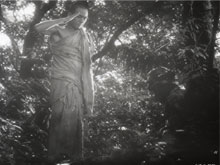
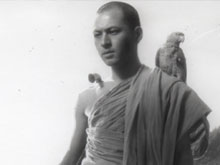
(c)1956 NIKKATSU CORPORATION
Directed by: Ichikawa Kon
Screenplay by: Wada Natto
Photography: Yokoyama Minoru
Art Director: Matsuyama Takashi
Music: Ifukube Akira
Based on a novel by: Takeyama Michio
CAST:
Mizushima: Yasui Shoji
Commander Inoue: Mikuni Rentaro
Sergeant Ito: Hamamura Jun
Commander at Sankakuyama: Mihashi Tatsuya
Village chief: Ito Yunosuke
An old peddler woman: Kitabayashi Tanie
SETTING: 1945
LOCATION: Some places in Burma
SYNOPSIS:
In the summer of 1945, the Japanese Army suffering a humiliating defeat on the Burma front, is attempt to escape into Thailand. Among such Japanese Army units, the INOUE company is making its way with a Burma harp accompaniment to the group singing. A private soldier MIZUSHIMA is an expert harpist and he goes on patrol missions disguised in Burmese costume, and guides the company with the harp playing as a signal. Near the border, the company is informed of the ending of the War. Discarding their weapons, they are to be taken to a prison-of-war camp in Mudon. MIZUSHIMA is sent to persuade a group of die-hards who refuse to surrender at Sankakuyama, but becomes lost and is missing. In Mudon the Inoue company when performing construction work, comes across a Burmese priest with a parrot on his shoulder resembling MIZUSHIMA very closely. They call out to the priest, but he hurries away without responce.
MIZUSHIMA is alive. On the way to try to join with his unit, he came across countless numbers of dead Japanese soldiers, and has made up his mind to becomes a priest to stay in Burma and appease their souls.
Commander INOUE buys a parrot from an old peddler woman, teaches it to say "MIZUSHIMA, let's go back to Japan" and asks her to give the parrot to the Burmese priest. On the day before the unit is to be shipped home to Japan, the Burmese priest appears at the camp, plays a Japanese song and goes away. On the following day, as the company is about to depart, the old peddler woman comes to hand over a letter from MIZUSHIMA together with the parrot. The parrot says, "Alas! I cannot return to Japan."
The Sun in the Last Days of the Shogunate -digitally restored version-
BAKUMATSU TAIYO-DEN 幕末太陽傳
B & W / Standard / 1957 / 111 min / Nikkatsu
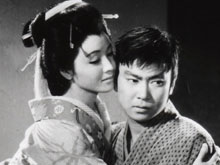
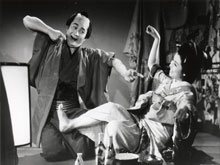
(c)1957 NIKKATSU Corporation
Directed by: Kawashima Yuzo
Screenplay by: Tanaka Keichi, Kawashima Yuzo, Imamura Shohei
Photography: Takamura Kurataro
Art Director: Nakamura Kimihiko, Chiba Kazuhiko
Music: Mayuzumi Toshiro
CAST:
Inokori Saheiji: Frankie Sakai
Osome: Hidari Sachiko
Koharu: Minamida Yoko
Takasugi Shinsaku: Ishihara Yujiro
Ohisa (a maid): Ashikawa Izumi
Mokubei (a rich man): Ichimura Toshiyuki
Denbei (the owner of the Sagamiya): Kaneko Nobuo
Otatsu (Denbei's wife): Yamaoka Hisano
Tokusaburo (their son): Umeno Yasukiyo
SETTING: 1860s
LOCATION: Tokyo (called Edo till 1968)
SYNOPSIS:
SAHEIJI and his fellows are found to be penniless after having their floric and fun at the Sagamiya, a brothel in Shinagawa. The brothel owner DENBEI, angered at them, takes SAHEIJI as hostage for payment of their debts and confines him in the shabbiest room in the house. However, instead of letting himself closed in, he voluntarily makes himself available as a manager. He collects a mortgage from TAKASUGI SHINSAKU, revolutionalist who stays with the popular prostitute KOHARU, for his debts. He smoothes out a quarrel between father and son who have found out each other's secret visits with KOHARU. Likewise, he cleverly manipulates among people and receives tips. Eventually, KOHARU and another prostitute OSOME fall in love with SAHEIJI, who, however, pays no attention to them. TOKUSABURO, the son of the Sagamiya, asks SAHEIJI to mediate his love to maid OHISA. Learning about TAKASUGI and his group's plan to burn down the British Embassy, SAHEIJI gets an interior sketch of the Embassy drawn by a carpenter and sells it to TAKASUGI at a high price. At the same time, he makes arrangements for TOKUSABURO and OHISA's elopement and lets them go hand in hand on board the boat leaving for a burn-down of the Embassy. MOKUBEI, KOHARU's patron, raises an uproar, being unable to find her. SAHEIJI tells him a lie that she has died, and takes him to a tombstone at a near-by graveyard. When his lie is revealed, MOKUBEI gets furious, but SAHEIJI ignores him and flees away.
Rusty Knife
SABIRETA NAIFU 錆びたナイフ
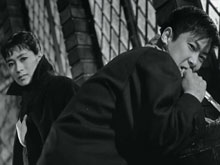
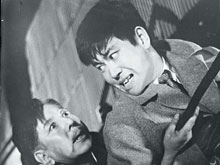
(c)1958 NIKKATSU Corporation
Directed by Toshio Masuda
Production Year: 1958
Length: 90 min
Cast: Yujiro Ishihara, Mie Kitahara
-Introduction-
Shady pasts come back to haunt two ex-thugs after going straight in this hit first feature from Toshio Masuda that cemented his place in the Nikkatsu action pantheon. Years after Tachibana (studio star Yujiro Ishihara) and Makoto (future big-shot Akira Kobayashi) accidentally witness a murder by a local crime heavy, a third witness threatens to sing like a canary, bringing Tachibana and Makoto’s names bubbling back to the surface in this stellar jazzy noir.
Twisted Path of Love
Kotbttotacht wa nureta 恋人たちは濡れた

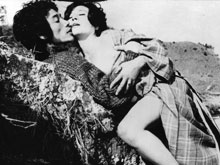
(c)1973 NIKKATSU CORPORATION
Color/ Scope / 1973 / 76 min / Nikkatsu
Director: Kumashiro Tatsumi
Script: Kumashiro Tatsumi, Kamoda Yoshifumi
Photography: Himeda Shinsaku
Art Director: Sakaguchi Takeharu
Music: Oe Tetsu
Producer: Miura Akira
Cast:
Nakagawa Katsu: Oe Tetsu
Yoko, Mitsuo's girlfriend: Nakagawa Rie
Yoshie, a theater proprietor: Ezawa Moeko
Mitsuo: Hori Koichi
Sachiko: Kei Chiro
Miura: Shimizu Kunio
Yoshie's husband: Takahashi Akira
Setting: A small fishing town in Chiba Prefecture in the early 1970s
Synopsis:
Hoping to leave behind his past in Tokyo. Nakagawa Katsu returns for the first time in five years to the small fishing village that was his hometown. There he works at a small porno movie theater, picking up the films and doing advertising. When people like the projectionist or his old classmate Miura recognize him, however, he persistently denies he is Katsu, to the point that Miura actually beats him up once. His consolation is his relationship with Yoshie, the wife of the theater owner who openly cheats on her.
One day, Katsu spies another former schoolmate, Mitsuo, having sex with his girlfriend Yoko in a field. When Katsu obnoxiously makes his presence known, Mitsuo first beats him up and then, having a change of heart, introduces Katsu to Sachiko, a woman who will supposedly have sex with anyone. Not really interested, but trying to play the part, Katsu walks off with Sachiko and suddenly tries to rape her when she asks him about his past. Disgusted with himself, however, he gives up halfway through.
Yoko and the others become more and more interested in Katsu's past, but he just continues his cynical performance of forgetting, having sex with Yoshie and singing on the streets to promote the theater. Mitsuo, Yoko, and Sachiko drag him to the beach and confront him with his mother, but Katsu rudely insists he has never seen this person before. As if to hide his feelings, he begins to rape Sachiko in front of Mitsuo and Yoko, who only sit by and comment on the two. Going back to town, Katsu tells Yoshie he is leaving, but not willing to let him go, she chases after him in the street as he leaves in Mitsuo's car. Desperate, she tries to hang herself at the local war memorial but fails.
Katsu hops on a bus to leave, but Yoko suddenly joins him. Mitsuo chases after them, after which the three play leapfrog on the beach. Stripping off their clothes, Katsu again watches Mitsuo and Yoko have sex in front of him, refusing to step in when Yoko asks for help. Later, when Katsu and Yoko are riding around in circles on a bicycle, he finally tells her his secret: he killed a man for money in Tokyo. She hardly believes him, but it is at that moment that a gangster runs up from behind to stab Katsu. Katsu rides the bicycle into the sea and sinks under the surface.
The Insect Woman
Nippon Konchuki にっぽん昆虫記
B&W / Scope / 1963 / 123 min / Nikkatsu
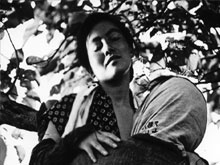
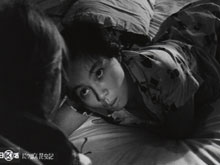
(c)1963 NIKKATSU Corporation
Ditected by: Imamura Shohei
Screenplay by: Hasebe Keiji, Imamura Shohei
Photography: Himeda Shinsaku
Art Director: Nakamura Kimihiko
Music: Mayuzumi Toshiro
Produced by: Otsuka Kano, Tomoda Jiro
CAST:
Matsuki Tome: Hidari Sachiko
Matsuki En: Sasaki Sumie
Matsuki Chuji: Kitamura Kazuo
Matsuki Nobuko: Yoshimura Jitsuko
Honda Toshizo: Tsuyuguchi Shigeru
Kambayashi Yoshiji: Hirata Daizaburo
Matsunami Morio: Nagato Hiroyuki
Karasawa: Kawazu Seizaburo
SETTING: 1918 - l960s
LOCATION: Somewhere in the countryside and Tokyo
SYNOPSIS:
TOME was born two months after her mother EN married CHUJI. Growing up in the confusion of her mother's life, TOME goes to work for a silk mill in 1941 at the age of 23. With the fall of Singapore to the Japanese army, TOME is called back home and enters the service of a local landlord. Here she is raped by TOSHIZO, son of the landlord, becomes pregnant and gives birth to a daughter, NOBUKO. At the end of the war she is having an affair with a superior named MATSUNAMI at the silk mill, where she has returned to work. In the turbulent postwar situation the company closes and then reopens, with TOME beginning to participate in labor union activities and her lover becoming a company director. TOME is fired.
Leaving NOBUKO in CHUJI's care, TOME sets out empty-handed for Tokyo. Where she becomes a maid prostitute around an American military base. Always thinking of her daughter back home, TOME descends to street-walking in order to provide as much money as possible for NOBUKO. Finally she becomes the mistress of a wholesale store owner, KARASAWA, and establishes her own call-girl ring, achieving economic stability at last. She summons NOBUKO and CHUJI to Tokyo. CHUJI, her emotional mainstay, dies soon after, and TOME is arrested and sentenced for prostitution. Coming back from prison, TOME finds that NOBUKO has sold herself to the wholesaler in order to earn the money she and her boyfriend called KAMBAYASHI need to go to some newly settled area and set up their own business. At the end of contract, NOBUKO and her man leave, while the wholesaler offers TOME the financing to set up her own store in Tokyo. But TOME follows her daughter back to the country, expecting to find peace in sharing the happiness of the independent young couple.
Retaliation
1968 Shima wa moratta 縄張はもらった
Director: Yasuharu Hasebe
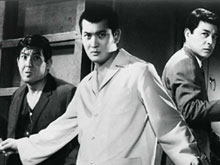
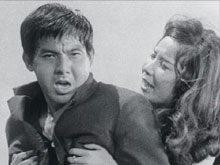
(c)1968 NIKKATSU Corporation
Yakuza lieutenant Kojiro Sagae (Akira Kobayashi) walks straight out of a stint in jail and into a power struggle between his old gang and newly emerging rivals. Kojiro sees the grim necessity of making one of them (played by Joe Shishido) into his new best yakuza 'frienemy'. But the calculus of loyalty starts getting complicated, deals are made and betrayed, and all ends in one of Nikkatsu's best bullet-ballet set-pieces, lit purely by battery torch and gun-muzzle flash. Hasebe’s hardboiled New Action take on underworld turf wars pits tough guy Akira Kobayashi against Joe Shishido. With Meiko Kaji.
Suzaki Paradise: Red Signal
Suzaki paradaisu akashingo 洲崎パラダイス 赤信号
B & W / Standard / 1956 / 82 min. / Nikkatsu
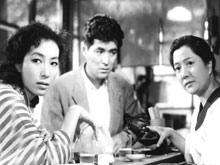
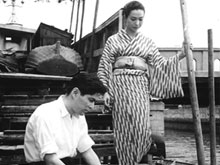
(c)1956 NIKKATSU CORPORATION
Director: Kawashima Yuzo
Script: Ide Toshiro, Terada Nobuyoshi
Photography: Takamura Kurataro
Art Direction: Nakamura Kimihiko
Music: Manabe Riichiro
Based on a novel by: Shibaki Yoshiko
Producer: Sakagami Shizuo
Cast:
Tsutae: Aratama Michiyo
Yoshiji: Mihashi Tatsuya
Madam Otoku: Todoroki Yukiko
Denshichi, her husband: Uemura Kenjiro
Tamako: Ashikawa Izumi
Ochiai, a radio shop owner: Kawatsu Seizaburo
A noodle shop keeper: Fuyuki Kyozo
Sankichi, an employee of the shop: Ozawa Shoichi
Setting: Tokyo in the 1950s
Synopsis:
In the mean streets of Tokyo's downtown, a young couple, having eloped, is stranded with no money. For those who tried to scratch a living for themselves in small businesses or trades, the mid-1950s were a time of uncertainty and want. The pleasure quarters vacated by American GIs were still in business, but money was tight and jobs scarce. Streetwalkers hovered around the border areas to the once thriving pleasure quarters, which were usually marked by garish red lights. Tiny, cheap cafes and bars eaked out a precarious existence catering to bored hustlers and lonely labourers.
The heroine, Tsutae, wanders with her taciturn man, Yoshiji, into one such cafe called the Chigusa. She talks her way into a job as waitress and dishwasher. With her flirtations and flattery, she helps business pick up, especially among older, wealthy men. Yoshiji, however, is left in the cold and becomes upset when Tsutae attaches herself to an affluent radio shop owner. But the sad, kindly Madam, Otoku, finds Yoshiji a situation at the local noodle shop.
Yoshiji has no aptitude nor interest in noodle delivery, but he soon revives when the young waitress, Tamako, takes a special interest in him. Meanwhile, Tsutae has gotten herself set up in a new apartment by her doting radio man. Tsutae, Yoshiji, Tamako, and a steady procession of drunks, labourers, shy couples and tarts come in and out of the Chigusa's doors, all looking for love, companionship, and the warmth of human contact or the bottle.
Tension builds through the hot summer nights. Tsutae and Yoshiji drive each other to fits of jealousy. Jazz, dixieland, and enka songs waft through the sweltering streets. Madam Otoku's husband, Denshichi, who had been living with another woman for years, suddenly appears. Madam Otoku and her two small children are overjoyed. The reunion of the family appears to have a calming effect on the whole community. But Denshichi's wandering past suddenly and violently overtakes him, to the shock of Madam Otoku. Tsutae, getting weary of life with her radio man, comes back to the area, and Yoshiji wavers between Tsutae and Tamako. The fated entanglement of Tsutae and Yoshiji makes them flee the Suzaki "Paradise" as suddenly as they came.
THE WHITE TIGER TATTOO (One Generation of Tattoos)
Irezumi Ichi-Dai 刺青一代
Color / wide /1965 / 87 min. / Nikkatsu
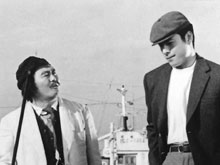
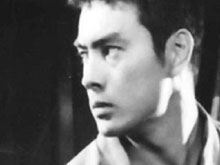
(c)1965 NIKKATSU Corporation
CAST:
Tetsutaro Murakami: Hideki Takahashi
Kenji Murakami: Kotobuki Hananomoto
Yuzo Kinoshita: Akira Yamauchi
Masayo Kinoshita: Hiroko Ito
Midori Kinoshita: Masako Izumi
Oyuki: Kayo Matsuo
Osamu Ezaki: Yuji Odaka
Tsunekichi: Tadashi Takashina
STAFF:
Producer: Nobutaka Sugiyama
Planning: Masayuki Takagi
Screenplay: Kinya Naoi, Yoshi Hattori
Photography: Kurataro Takamura
Art Director: Takeo Kimura
Music: Masayoshi Ikeda
Director: Seijun Suzuki
Tokyo in the early twentieth century was a boisterous place. Tetsutaro Murakami has entered the world of the 'Yakuza,' or gangsters, in part to help his artistic brother Kenji get through art school. Tetsutaro is known as 'Tetsu the White Tiger' for the magnificent tattoo on his body.
Following the rigid code of the Yakuza, he kills a rival gang boss as ordered. But then he is double-crossed and is nearly killed himself - only to be saved by his brother who happens to be passing by and in fear kills his brother's would-be assassin. Now, they are both outlaws, pursued by the police and a particularly ruthless detective.
They decide to escape to Manchuria and start new lives and set out for a port to find passage to China. But they are tricked out of the fare and left stranded and penniless.
Through the good graces of the daughter of a mine owner and a fierce fight with the miners' unofficial boss, they gain acceptance at the mine. But Kenji is attracted to the wife of the owner, and the daughter is attracted to Tetsu. Kenji continues sketching in his spare time - including sketches of the owner's wife, which gets him into trouble, and Tetsu takes to gambling with the miners.
The wife also develops a passion for Kenji which becomes known, although Tetsu tries to cover it, in the meanwhile he is having trouble keeping the daughter away.
But when an accident happens at the mine, Kenji is blamed by the jealous husband, and Tetsu's past is also revealed. Tetsu is locked up to wait for the authorities, but a vengeful gang has also discovered his whereabouts.
The miners find the real culprit for the accident, and punish him, but the brothers decide to leave. Yet when it comes to once again going to Manchuria, Kenji feels he cannot leave without seeing the woman he loves once more, even though they are being pursued. Kenji is beaten and killed.
Tetsu's fury at losing his beloved brother knows no bounds and he sets out on a furious and magnificent revenge in which he eliminates all their enemies.
About the Panelists
PANEL #1: NIKKATSU AND THE WORLD OF JAPANESE ENTERTAINMENT 6:00 P.M. on Saturday, October 27th, 2012
Sandy Climan, CEO and Representative Board Director, All Nippon Entertainment Works (ANEW)
Sandy Climan is the CEO and Representative Board Director of All Nippon Entertainment Works (ANEW), a global entertainment studio with offices in Tokyo and Los Angeles that adapts, co-develops and produces the best creative properties and brands from Japan into English language, global entertainment, in partnerships with established Hollywood studios and world-class filmmakers.
Mr. Climan is also the founder of Entertainment Media Ventures, Inc., a company active in media investment and strategic advisory work, with a particular focus on innovative technologies pushing forward the boundaries of media and entertainment. Mr. Climan has also been active in both motion picture and television production, most notably as Executive Producer of the first digital live-action 3D motion picture, “U2 3D,” Co-Executive Producer of the CBS primetime series “Robbery Homicide Division,” and as Producer of “The Aviator,” the Howard Hughes biographical feature film directed by Martin Scorsese and starring Leonardo DiCaprio, for which Mr. Climan was awarded a British Academy Award and a Golden Globe Award.
Mr. Climan has served in a number of corporate senior management positions in media and entertainment. From 2007 to 2010, Mr. Climan served as the first CEO of 3ality Digital, a leading company in the development and commercialization of technologies which enable perfect digital 3D image capture, digital 3D broadcast and software that enables consumer applications of 3D entertainment. Within four years, Mr. Climan took the company from no certified products to 3ality being recognized as a global leader in 3D technology.
Earlier positions have included Executive Vice President and President of Worldwide Business Development of Universal Studios from 1995 to 1997, and as a member of the senior management team at Creative Artists Agency from 1986 to 1995 and 1997 to 1999, serving as both a talent agent and as founding head of CAA’s corporate representation practice. At Universal, Mr. Climan oversaw corporate international strategy, strategic marketing and five studio operating divisions with $1.4 billion in sales: Consumer Products, Home Video, Pay Television, New Media and Spencer Gifts. At CAA, Mr. Climan was part of the senior management team for 12 years, representing talent including Robert De Niro, Robert Redford, Kevin Costner, Danny DeVito, and Michael Mann. Mr. Climan also served as the founding head of CAA’s corporate practice, working with global companies including Sony Corporation on its acquisition of Columbia Pictures, Matsushita Electric on its acquisition of MCA/Universal, Coca-Cola on revitalizing its advertising, Credit Lyonnais on the restructuring of MGM, and NYNEX, Bell Atlantic and Pacific Telesis on the creation of their video joint venture, Tele-TV.
Prior to joining CAA, Mr. Climan held various executive positions in the entertainment industry. He served as President of Lion’s Gate Studios; President of Wescom Productions, a subsidiary of Chronicle Publishing; and Vice President of Production for The David Gerber Company, a major independent television company. He began his career at Metro-Goldwyn-Mayer, overseeing pay-television, international theatrical distribution and, later, working in feature film production.
Mr. Climan serves on several charitable boards, including The American Cinematheque, The Fulfillment Fund, The Chief Executive Leadership Institute of the Yale School of Management, and the UCLA School of Theater, Film and Television. He has served as member of the Advisory Committee to the Director of the Centers for Disease Control and Prevention, and also serves as an advisor on entertainment and media to the World Economic Forum and its Annual Gathering in Davos, Switzerland.
Akira Mizuta Lippit, Ph.D. (Moderator)
Akira Mizuta Lippit is Professor and Chair of Critical Studies in the School of Cinematic Arts, and Professor in the Departments of Comparative Literature and East Asian Languages and Cultures in the USC Dornsife College. His interests are in world cinemas, critical theory, Japanese film and culture, experimental film and video, and visual studies. Lippit’s published work reflects these areas and includes three books, Atomic Light (Shadow Optics) (2005) and Electric Animal: Toward a Rhetoric of Wildlife (2000), and a forthcoming book on contemporary avant-garde media, Ex-Cinema: From a Theory of Experimental Film and Video (2012). At present, Lippit is completing a book on contemporary Japanese cinema, which looks at the relationship of late-twentieth and early twenty-first century Japanese culture to the concept of the world, and another on David Lynch’s baroque alphabetics.
His work appears widely in journals and anthologies, and has been translated into Croatian, French, German, Italian, Japanese, Korean, Polish, and Spanish. He is past recipient of the Fulbright-Hays and Japan Foundation awards.
Lippit is the General Editor of the journal Discourse, and is active in the independent film community where he programs events, serves on festival juries, and interviews filmmakers. He regularly teaches, lectures, and publishes in Japan, where he is a founding editor of the visual culture journal Ecce.
Naoki Sato, President and CEO, Nikkatsu Corporation
As a producer, Sato was responsible for many successful films at Daiei/Kadokawa (Daiei was acquired by Kadokawa in 2002). Since 2005, he has headed NIKKATSU Corporation as President & CEO, and continues producing many films. His films as a produced include the monster movie sensation Gamera series (1995-99, Daiei), the box-office blockbuster Death Note series (2006-08, NIKKATSU), SFX smash hit Yatterman (2008, NIKKATSU) and multiple Japanese Academy Award winner Rebirth (2011, NIKKATSU).
PANEL #2: THE GLOBAL STUDIO AT 100 5:00 P.M. on Sunday, October 28th, 2012
Richard B. Jewell, Ph.D. (Moderator)
Rick Jewell teaches survey courses on American film history at both the graduate and undergraduate levels, as well as courses on media censorship, film genres (the Western; the Gangster film), film style analysis (RKO and the Studio System; the James Bond films) and seminars on national cinema (Italian Cinema; American Film, 1939-45; American Film 1967-72).
Sought after for his perspectives on the full range of topics related to film during the initial years of sound, Dr. Jewell has done commentaries on the films Little Caesar, I Am a Fugitive From a Chain Gang and G Men, an introduction to the MGM film The Postman Always Rings Twice, and he has appeared in special features on many discs. He estimates that he’s been filmed for more than 25 documentaries, including collections of films with Fred Astaire and Ginger Rogers, Bette Davis and Humphrey Bogart.
Dr. Jewell is the author of The RKO Story, The Golden Age of Cinema: Hollywood, 1929-1945, and co-author of Primary Cinema Resources and has published articles in a variety of journals including The Historical Journal of Film, Radio and Television, Film History, and Film Quarterly.